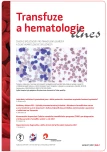Muscle pain as a rare autoimmune symptom of monoclonal IgM gammopathy – case report and overview of autoimmune manifestations associated with monoclonal immunoglobulins
Authors:
Z. Král; M. Krejčí; L. Pour; Z. Adam
Authors‘ workplace:
Interní hematologická a onkologická klinika LF MU a FN Brno
Published in:
Transfuze Hematol. dnes,27, 2021, No. 1, p. 57-61.
Category:
Case Report
doi:
https://doi.org/10.48095/cctahd202157
Overview
This article describes a rare case of Waldenström’s macroglobulinemia with autoimmune myopathy and presents a short overview of other possible autoimmune manifestations associated with the presence of monoclonal immunoglobulin (MIg). In our patient, Waldenström’s macroglobulinemia manifested as chronic muscle pain and anaemia. The patient suffered from back muscle pains for about 3 years before being diagnosed with WM, with progression of myalgia and pain of the upper and lower limbs in the last year prior to diagnosis. Serum myoglobin and creatinkinase (CK) levels were significantly increased. Polymyositis was not confirmed. The diagnosis of WM was established in 2014, with typical infiltration with lympho-plasmacytoid lymphoma in the bone marrow and the presence of IgM lambda paraproteinemia in the serum. The patient started treatment with the anti-CD20 monoclonal antibody rituximab, cyclophosphamide and dexamethasone and received 8 cycles from 7/2014–2/2015. The IgM disappeared, the immunofixation results normalised as did myoglobin, CK and haemoglobin after the 5th cycle and there was significant improvement of muscle pain. The patient achieved a complete remission with no signs of relapse/progression at the last follow-up in 12/2019 with normal or only mildly elevated CK and myoglobin.
Keywords:
Waldenström’s macroglobulinemia – autoimmune myopathy – rituximab
Sources
1. Kaščák M, Hájek R, Minařík J, et al. Diagnostika a léčba Waldenströmovy makroglobulinemie. Transfuze Hematol Dnes. 2019; 25 (Suppl 1): 7–33.
2. Treon SP. How I treat Waldenström macroglobulinema. Blood. 2015; 126 (6): 721–732.
3. Bulikova A, Smejkal P, Zavřelová J, et al. Získané inhibitory krevního srážení. Int Med Prax. 2008; 10: 336–339.
4. Al-Lozi MT, Pestronk A, Yee WC, et al. Myopathy and paraproteinemia with serum IgM binding to a high-molecular-weight muscle fiber surface protein. Ann Neurol. 1995; 37: 41–46.
5. Bakri K, Haydar AA, Davis J, et al. Waldenström‘s macroglobulinaemia presenting as isolated epistaxis: a common complaint but a rare cause. Int J Clin Pract. 2004; 58: 81–82.
6. Deconinck N, Laterre EC, Van den Bergh PY. Adult-onset myopathy and monoclonal gammopathy: a case report. Acta Neurol Belg. 2000; 100: 34–40.
7. Eymard B, Brouet JC, Collin H, et al. Late-onset rod myopathy associated with monoclonal gammopathy. Neuromuscul Disord. 1993; 3 (5–6): 557–560.
8. Keller CE, Hays AP, Rowland LP, et al. Adult-onset myopathy and monoclonal gammopathy. Arch Neurol. 2006; 63 (1): 132–134.
9. Bockorny B, Atienza J, Dasanu CA. Autoimmune manifestation in patients with Waldenström macroglobulinemia. Lymphoma Myeloma Leuk. 2014; 14: 456–549.
10. Stone MJ. Pathogenesis and morbidity of autoantibody syndromes in Waldenstrom‘s macroglobulinemia. Clin Lymphoma Myeloma Leuk. 2011; 11: 157–159.
11. Sakalová A, Škultétyová D, Konečná Z, et al. Súčasná klasifikácia, diagnostika a prognóza primárnych monoklonových gamapatií (paraproteinémií) Transfuze Hematol Dnes. 2010; 16: 193–201.
12. Kyle RA. Morbus Waldenström: an overview of diagnosis and therapy. Transfuze Hematol Dnes. 2008; 14 (Suppl 1): 105–107.
13. Al-Lozi M, Pestronk A. Organ-specific autoantibodies with muscle weakness. Curr Opin Rheumatol. 1999; 11: 483–488.
14. Carlizzi G, Ciarla MV, Diluzio A, et al. Autoantibodies in patients with monoclonal gammopathies. Ann N.Y. Acad Sci. 2007; 1107: 206–2011.
15. Stone MJ, McElroy A, Pestronk P, et al. Human monoclonal macroglobulins with antibody activity. Semin Oncol. 2003; 30: 318–324.
16. Stone MJ, Marlini V, Pascual J. Autoantibody aktivity in Waldenström’s macroglobulinaemia. Clin Lymphoma. 2005; 5: 225–229.
17. Ansell SM. Waldenström macroglobulinemia and autoimunity: what’s the connection? Leuk Lymphoma. 2015; 6: 845–846.
18. Jonsson V, Kierkegaard A, Salling S, et al. Autoimunity in Waldenström’s macroglobulinemia. Leuk Lymphoma. 1999; 34: 373–379.
19. Nakazaki K, Hangaishi A, Nakamura F, et al. IgG-associated immune thrombocytopenia in Waldenström macroglobulinemia. Int J Hematol. 2010; 92: 360–363.
20. Maisnar V, Hájek R. Rizikové monoklonální gamapatie nejasného významu – léčit nebo neléčit? Transfuze Hematol Dnes. 2013; 19: 22–26.
21. Kaščák M, Ďuraš J, Navrátil M, et al. Autologní transplantace kmenových buněk u Waldenströmovy makroglobulinemie. Transfuze Hematol Dnes. 2016; 22: 28–38.
22. Adam Z, Hájek R, Krejčí M, et al. Diagnostika a léčba Waldenströmovy makroglobulinemie. Transfuze Hematol Dnes. 2014; 20 (Suppl 1): 7–22.
Labels
Haematology Internal medicine Clinical oncologyArticle was published in
Transfusion and Haematology Today

2021 Issue 1
- Administration of aPCC as a Prevention of Bleeding After Major Cardiac Surgical Procedures
- The Importance of Hydration in Wound Healing
- Cost Effectiveness of FVIII Substitution Versus Non-Factor Therapy for Hemophilia A
- Vascular Disease in the Gradually Aging Population of Hemophiliacs: An Underestimated Problem?
- Prognostic Significance of Subclinical Joint Changes on MRI in Hemophilia
Most read in this issue
- Heparin induced thrombocytopenia
- Blood cell analysers – signifi cance of a dimorphic red blood cell population
- Recommendations for chronic lymphocytic leukaemia diagnosis and therapy 2021
- Novel molecules used in the targeted treatment of acute myeloid leukaemia – adverse reactions, treatment complications and signifi cant drug interactions
